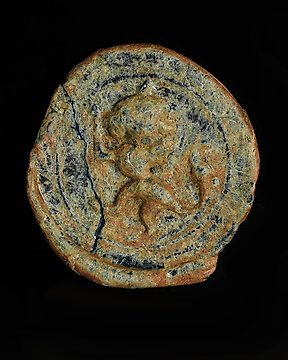
Ancient Roman Glass Blue Medallion with Zoomorphic Creature (No Reserve Price)
No. 81073749

No. 81073749

A Romano-Egyptian glass inlay, in form of an oblong green face with fine facial features. The eyes are comprised of concentric circles in black and yellow, around a dark red dot depicting the pupil. Between the eyes is an orange protrusion, representing the nose. The mouth is formed by two thin black lines at the bottom. The green face has been fused onto a transparent reverse, which displays fine lines, adding texture to the piece. Repairs to the left side and the nose.
The green face, as seen on this piece, is believed to be associated with Osiris, the Egyptian god of fertility, death and afterlife. He is frequently depicted in the tombs with a green skin which symbolises rebirth. Glass inlays, in the shape of deities, animals, body parts and generic figures, would have been used to decorate wooden shrines, in which statuettes of gods and goddesses were housed. Such wooden shrines would have been placed in temples, and would have appeared richly inlaid with figural, hieroglyphic, and decorative glass elements.
Measurements: L 1.6cm x W 0.7cm x H 0.4cm
Provenance: From a private UK collection, 1920's - 1940's.
How to buy on Catawiki
1. Discover something special
2. Place the top bid
3. Make a secure payment